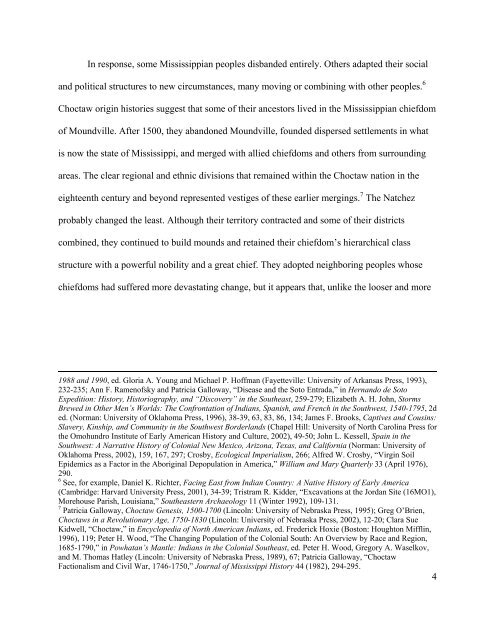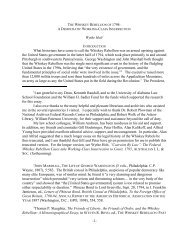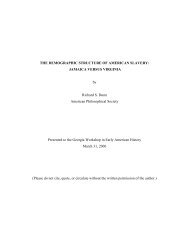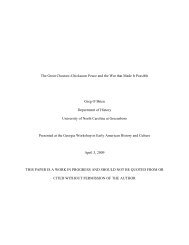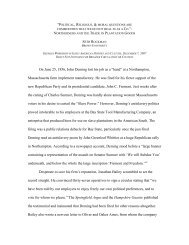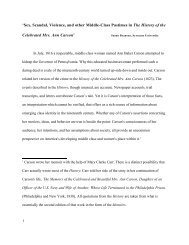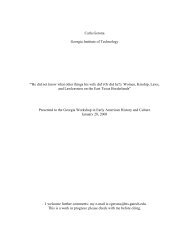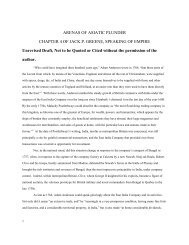Interconnectedness and Diversity in ?French Louisiana? - Georgia ...
Interconnectedness and Diversity in ?French Louisiana? - Georgia ...
Interconnectedness and Diversity in ?French Louisiana? - Georgia ...
You also want an ePaper? Increase the reach of your titles
YUMPU automatically turns print PDFs into web optimized ePapers that Google loves.
In response, some Mississippian peoples disb<strong>and</strong>ed entirely. Others adapted their social<br />
<strong>and</strong> political structures to new circumstances, many mov<strong>in</strong>g or comb<strong>in</strong><strong>in</strong>g with other peoples. 6<br />
Choctaw orig<strong>in</strong> histories suggest that some of their ancestors lived <strong>in</strong> the Mississippian chiefdom<br />
of Moundville. After 1500, they ab<strong>and</strong>oned Moundville, founded dispersed settlements <strong>in</strong> what<br />
is now the state of Mississippi, <strong>and</strong> merged with allied chiefdoms <strong>and</strong> others from surround<strong>in</strong>g<br />
areas. The clear regional <strong>and</strong> ethnic divisions that rema<strong>in</strong>ed with<strong>in</strong> the Choctaw nation <strong>in</strong> the<br />
eighteenth century <strong>and</strong> beyond represented vestiges of these earlier merg<strong>in</strong>gs. 7 The Natchez<br />
probably changed the least. Although their territory contracted <strong>and</strong> some of their districts<br />
comb<strong>in</strong>ed, they cont<strong>in</strong>ued to build mounds <strong>and</strong> reta<strong>in</strong>ed their chiefdom’s hierarchical class<br />
structure with a powerful nobility <strong>and</strong> a great chief. They adopted neighbor<strong>in</strong>g peoples whose<br />
chiefdoms had suffered more devastat<strong>in</strong>g change, but it appears that, unlike the looser <strong>and</strong> more<br />
1988 <strong>and</strong> 1990, ed. Gloria A. Young <strong>and</strong> Michael P. Hoffman (Fayetteville: University of Arkansas Press, 1993),<br />
232-235; Ann F. Ramenofsky <strong>and</strong> Patricia Galloway, “Disease <strong>and</strong> the Soto Entrada,” <strong>in</strong> Hern<strong>and</strong>o de Soto<br />
Expedition: History, Historiography, <strong>and</strong> “Discovery” <strong>in</strong> the Southeast, 259-279; Elizabeth A. H. John, Storms<br />
Brewed <strong>in</strong> Other Men’s Worlds: The Confrontation of Indians, Spanish, <strong>and</strong> <strong>French</strong> <strong>in</strong> the Southwest, 1540-1795, 2d<br />
ed. (Norman: University of Oklahoma Press, 1996), 38-39, 63, 83, 86, 134; James F. Brooks, Captives <strong>and</strong> Cous<strong>in</strong>s:<br />
Slavery, K<strong>in</strong>ship, <strong>and</strong> Community <strong>in</strong> the Southwest Borderl<strong>and</strong>s (Chapel Hill: University of North Carol<strong>in</strong>a Press for<br />
the Omohundro Institute of Early American History <strong>and</strong> Culture, 2002), 49-50; John L. Kessell, Spa<strong>in</strong> <strong>in</strong> the<br />
Southwest: A Narrative History of Colonial New Mexico, Arizona, Texas, <strong>and</strong> California (Norman: University of<br />
Oklahoma Press, 2002), 159, 167, 297; Crosby, Ecological Imperialism, 266; Alfred W. Crosby, “Virg<strong>in</strong> Soil<br />
Epidemics as a Factor <strong>in</strong> the Aborig<strong>in</strong>al Depopulation <strong>in</strong> America,” William <strong>and</strong> Mary Quarterly 33 (April 1976),<br />
290.<br />
6<br />
See, for example, Daniel K. Richter, Fac<strong>in</strong>g East from Indian Country: A Native History of Early America<br />
(Cambridge: Harvard University Press, 2001), 34-39; Tristram R. Kidder, “Excavations at the Jordan Site (16MO1),<br />
Morehouse Parish, <strong>Louisiana</strong>,” Southeastern Archaeology 11 (W<strong>in</strong>ter 1992), 109-131.<br />
7<br />
Patricia Galloway, Choctaw Genesis, 1500-1700 (L<strong>in</strong>coln: University of Nebraska Press, 1995); Greg O’Brien,<br />
Choctaws <strong>in</strong> a Revolutionary Age, 1750-1830 (L<strong>in</strong>coln: University of Nebraska Press, 2002), 12-20; Clara Sue<br />
Kidwell, “Choctaw,” <strong>in</strong> Encyclopedia of North American Indians, ed. Frederick Hoxie (Boston: Houghton Miffl<strong>in</strong>,<br />
1996), 119; Peter H. Wood, “The Chang<strong>in</strong>g Population of the Colonial South: An Overview by Race <strong>and</strong> Region,<br />
1685-1790,” <strong>in</strong> Powhatan’s Mantle: Indians <strong>in</strong> the Colonial Southeast, ed. Peter H. Wood, Gregory A. Waselkov,<br />
<strong>and</strong> M. Thomas Hatley (L<strong>in</strong>coln: University of Nebraska Press, 1989), 67; Patricia Galloway, “Choctaw<br />
Factionalism <strong>and</strong> Civil War, 1746-1750,” Journal of Mississippi History 44 (1982), 294-295.<br />
4


